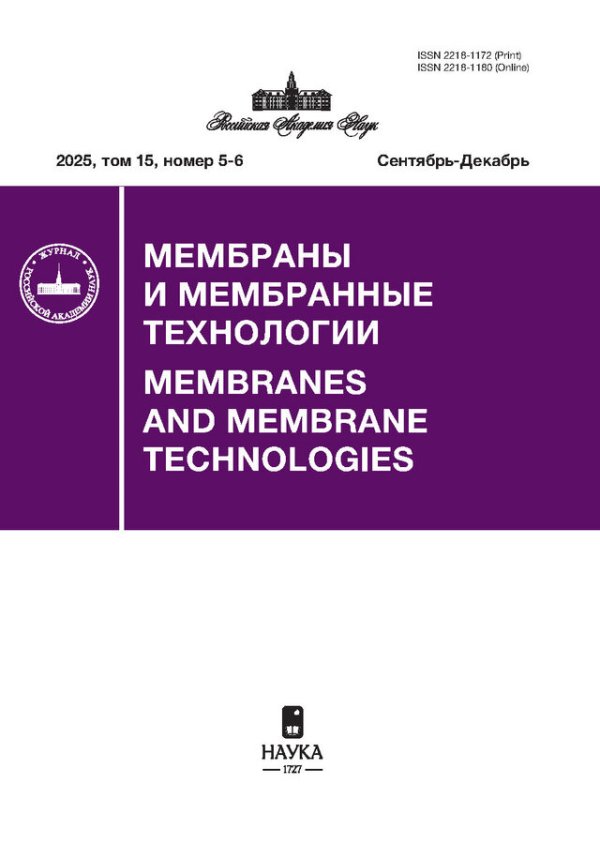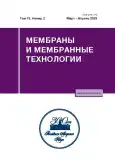Vol 13, No 2 (2023)
Steam Conversion of Ethane and Methane–Ethane Mixtures in Membrane Reactor with a Foil from Pd–Ru Alloy
Abstract
The features of steam conversion of ethane and methane-ethane mixtures containing 5, 10 and 15% ethane in a membrane reactor with a 30 μm thick Pd–Ru foil at temperatures of 1800 and 3600 h–1 and steam/feed rations of 3 and 5 have been investigated. Comparative experiments with “non-membrane” reaction have shown that in the membrane reactor the feedstock conversion to form H2 and CO2 increases and ethane hydrocracking decreases. Increasing the rate of H2 recovery through the membrane by permeate evacuation leads to an increase in the yield of H2 and CO2. With a decrease in the steam/feed ratio from 5 to 3, the ethane hydrocracking and the rate of carbon deposits formation increases. Optimal conditions for steam conversion of ethane and methane-ethane mixtures are T = 773 K, feed space velocity of 1800 h–1 and steam/feed ratio of 5. The established regularities are similar to those obtained earlier for other types of raw materials (mixtures of methane with propane, propane, n-butane, a mixture simulating the average composition of associated petroleum gas) in this membrane reactor.
 83-95
83-95


Hybrid Technology Seawater Desalination Based on Reverse Osmosis and Membrane Distillation Methods
Abstract
The article presents the results of a computational and analytical study of hybrid RO–MD (Reverse Osmosis–Membrane Distillation) technologies for desalination of the Caspian Sea, providing for the production of an additional amount of desalinated water by the MD method from RO concentrates heated to 50–80°C due to waste heat of fuel combustion products in steam boilers. Two options for solving the problem of the formation of CaCO3 and CaSO4 precipitates on membranes were studied: with preliminary nanofiltration (NF) or Na-cationation (Na) of sea water, as an alternative to the use of antiscalants (AS) and acid. The negative environmental effect of most plants (eutrophication of water bodies) and their low efficiency at high concentrations of desalinated water are taken into account. The Langelier index (СаСО3) and the degree of concentrate saturation (СаSO4) were used as criteria for precipitation of deposits on the membranes. The NF and RO processes were studied using the ROSA computer program, and the MD and Na processes were studied by computer simulation of the corresponding calculation models. It was found that at a 70% permeate yield at the NF and RO stages, the possibility of calcium precipitation on the RO and MD membranes is prevented, but their precipitation on the NF membranes is predicted, which makes the use of AS forced. At the same time, additional permeate production at the MD stage from RO concentrates reaches 40% of the amount of permeate from RO stadium, and the electricity consumption in general according to the scheme is 1.88 kWh/m3. Reducing the calcium hardness of sea water to 50 µg-eq/dm3 by the Na-cationization method makes it possible to refuse both the use of AS and acidification with sulfuric acid with additional production of MD permeate – 27% relative to RO permeate. Electricity consumption rises to 2.5 kWh/m3. To use the known advantages of NF without the use of AS, a hybrid Na–NF–RO–MD scheme is proposed. It has been established that at 80% yields of NF and RO permeates, to prevent the formation of CaSO4 precipitates at all stages of treatment, it is sufficient to reduce the hardness of sea water from 16 to 5.5 m-eq/dm3, and by acidifying the softened water to exclude the formation of CaCO3 precipitates.
 96-109
96-109


Structural Features of 4-VP-HEMA-SiO2 Hybrid Membranes and Their Proton Conductivity
Abstract
Hybrid organic-inorganic membranes based on tetraethoxysilane and orthophosphoric acid-doped copolymers of 4-vinylpyridine (4-VP) and 2-hydroxyethyl methacrylate (HEMA) were formed by the sol-gel synthesis method. The membranes are characterized by high values of exchange capacity and proton conductivity. An increase in the proton conductivity of hybrid organo-inorganic membranes compared to the initial copolymer can be associated with the generation of water of crystallization during the formation of a silicon dioxide fragment, which follows from quantum-chemical modeling of the local structure of the membrane, which includes an organic part from the copolymerization product of 4-VP with HEMA (44 atoms) and an inorganic part of 27 atoms, repeating the structure of the silicon dioxide block.
 110-116
110-116


The Influence of Low-Temperature Plasma on the Structure of Surface Layers and Gas-Separating Properties of Polyvinyltrimethylsilane Membranes
Abstract
New results of one-sided surface modification of polymeric films and composite membranes of polyvinyltrimethylsilane (PVTMS) using low-temperature plasma are presented. The treatment was carried out by direct current discharge at the cathode and anode, air was used as the working gas, the exposure time was from 10 to 60 s, and the working pressure in the chamber was 15–20 Pa. The structure of the surface layers was analyzed by XPS, AFM and SEM, and the contact properties of the surface were also studied. The effective permeability coefficients for O2, N2, CH4, CO2, He, and H2, as well as for gas diffusion, for cathode-treated PVTMS films are experimentally obtained, and the effective gas solubility coefficients are calculated. The permeability coefficients of the studied gases for composite membranes with a selective PVTMS layer modified at the cathode and anode were determined. It has been noted that the choice of electrode significantly affects not only the chemical structure of the surface and near-surface layers of PVTMS, but also the gas transport parameters of the modified samples. At the same time, during the treatment of PVTMS films at the cathode for 30 s, it was possible to achieve an increase in the O2/N2 selectivity by more than two times relative to the initial value. It has been established that the results of modification of composite membranes differ from those obtained for homogeneous films and it was possible to achieve O2/N2 selectivity in 2.5 times higher than the initial value. The potential of using surface modification of polymer films and membranes by low-temperature plasma to improve their gas separation properties is shown.
 117-127
117-127


The Potential of Polymer Membranes for Recovery of Xenon from Medical Waste Gas Mixtures
Abstract
This work is devoted to the evaluation of xenon permeability coefficients for a wide range of polymeric membrane materials, as well as the primary experimental verification of the calculation results for materials used in the production of gas separation membranes. Emphasis is placed on solving the problem of O2/Xe mixture separation as a base for xenon-containing waste medical gas mixtures where it is possible to recover xenon for its reuse. The xenon permeability coefficients were evaluated using a correlation approach, that relates the molecular properties of a gas to gas permeability, and available literature data on the permeability of other gases. The results obtained make it possible to distinguish two main groups of membrane polymers in the Robson diagram for O2/Xe gas pair: xenon-selective (polysiloxane-based rubbers and highly permeable functional polyacetylenes) and oxygen-selective (polyimides, PIMs, perfluorinated polymers). Industrial composite membrane MDK with a selective layer of silicone copolymer and laboratory composite membranes based on PSf and PVTMS were experimentally investigated. The obtained data demonstrate satisfactory convergence of the experimental values with the estimated ones. Based on the results obtained, MDK membrane can be recommended as xenon-selective for xenon recovery.
 128-136
128-136


Features of the Process of Galvanic Deposition of Metals into the Ion Track Membranes’ Pores
Abstract
The paper considers some aspects of obtaining metal nanowires by matrix synthesis based on track membranes. In the first part of the paper, the main ideas of the method are considered and a review of the literature on the synthesis of nanowires of various types of single component (from one metal) and multicomponent—from two or more metals is given. In the second part of the review, variants of obtaining homogeneous structures of so-called alloyed nanowires and heterogeneous structures of so-called layered nanowires are considered. Several specific features of the electrodeposition method during the process in a limited volume of membrane pores are considered. In the second part of the work, the experimental results obtained by the authors in the study of electrodeposition of nanowires made of an iron–nickel alloy are considered. The so-called abnormal electrodeposition of iron was detected. The dependence of the integral element composition of the obtained nanowires on the pore diameter and on the growth voltage is discussed. Data on the nature of the distribution of elements along the length of nanowires are obtained. The unevenness of the composition is determined by the conditions of production (in particular, the different diffusion mobility of ions in narrow pore channels) and also depends on the voltage and diameter of the pore channels. Based on the X-ray diffraction data, the type of lattice (hcc) is determined and the nature of the change in the lattice parameter is shown, presumably associated with the difference in the ionic radii of metals.
 137-149
137-149


Synthesis and Properties of Poly(4-methyl-2-pentyne) Containing Quaternary Ammonium Salts with Methyl and Ethyl Substituents
Abstract
In this work, functionalization of poly(4-methyl-2-pentyne) (PMP) with quaternary ammonium salts was carried out in order to increase CO2 selectivity in its membrane recovery. The introduction of functional groups was carried out by a two-stage method – bromination of the initial polymer and addition of tertiary alkylamines trimethylamine (TMA) and trimethylamine (TEA). It has been established that the optimal amount of introduced functional groups, while maintaining the mechanical properties of the polymer, is up to 5 mol. %. The results of organoelemental analysis and IR spectroscopy confirm the functionalization reaction of the PMP. X-ray diffraction patterns of the samples indicate an increase in the interchain distance in the series initial PMP–brominated PMP–functionalized PMP. TGA data confirm high thermal and thermal-oxidative stability. The coefficients of permeability, solubility and diffusion of PMP samples containing TMA and TEA salts were determined for individual gases. An increased ideal selectivity for the separation of gas pairs CO2/N2 by 2–3 times and CO2/CH4 by 1.5–2 times has been achieved while maintaining the permeability at a high level.
 150-160
150-160












